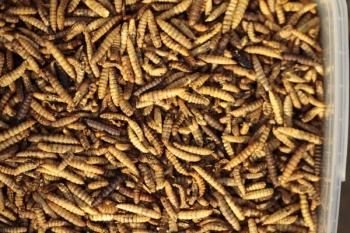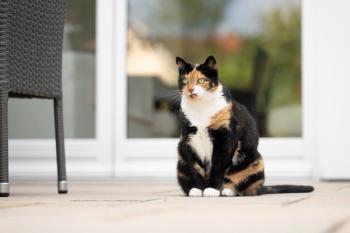
Feline hyperthyroidism: Is there evidence for a nutritional cause? (Proceedings)
Since reports of feline hyperthyroidism began to appear from around the world in 1980, this disease has become the most common endocrinopathy in cats.
Investigations on Etiopathogenesis
Since reports of feline hyperthyroidism (HT) began to appear from around the world in 1980, this disease has become the most common endocrinopathy in cats. The age-specific prevalence of feline HT has increased between 1978 and 1997. Cats are the only nonhuman mammalian species with a high incidence of HT. Two mechanisms underlying the possible pathogenesis of this disease have been explored: an autoimmune-related mechanism (similar to toxic nodular goitre [TNG] in humans) or intrinsic autonomy of the growth and function of follicular cells. Experimental support for an immune etiology is lacking as autoantibodies are not found in affected cats. Therefore, investigations have focused on possible host factors and/or environmental reasons for intrinsic autonomy of thyroid follicular function. None of the studies to date have isolated a single dominant factor that could be universally incriminated in the development of hyperthyroidism in cats. Many authors believe that hyperthyroidism is a multifactorial disease in this species.
Somatic mutations in the G(s alpha) gene or in exon 10 of the thyroid-stimulating hormone (TSH) receptor gene have been identified in a few HT cats, providing an interesting parallel to TNG, but failing to account for the majority of cases of feline HT. Decreased expression of an inhibitory subset of guanosine triphosphate-binding proteins [G(i2) proteins] may help explain the molecular mechanism of feline HT but fails to provide information about etiology.
Extrinsic factors strongly or consistently associated with HT in case-control studies include: using cat litter, eating a diet composed mainly of canned food particularly fed from pop-top cans, living in a single-cat household, sleeping on the floor, and regular treatment of cat bedding with anti-flea products. In evaluating such results, it is important to remember that epidemiological studies cannot prove causality (show the direction of an association). In addition, factors demonstrating an association with HT could be confounded by a factor not examined in the survey. Most recently, interest has focused on the results of an epidemiologic study showing an association between HT and exposure to the flame-retardant chemicals, polybrominated diphenyl ethers (PBDEs) in canned cats foods or household dust. These intriguing results, however, fail to provide a logical explanation as to why cats are predisposed to HT if they live close to an ocean or one of the Great Lakes in North America , why cats of specific breeds are protected from developing this disease, and why colony cats with no exposure to carpets or furniture also have a high incidence of HT. Environmental iodine concentrations are much higher in regions in close proximity to the ocean. Iodine intake, however, which has a well-established causal relationship with goitre in humans, has failed to show a relationship to HT in cats. Purebred cats, especially Siamese and Himalayan cats, are at significantly lower risk of developing HT than domestic short- or long-haired cats. Speculation has focused around a possible genetic basis for this protective effect. Another explanation is that light coat color is protective. Tyrosine, the amino acid that is the precursor to melanin, the dark pigments in skin or hair (regardless of actual coat color), is also the precursor to thyroid hormone, as thyroxine (T4) contains the amino acid tyrosine in the center, surrounded by four iodine molecules. No studies have been published evaluating tyrosine intake and thyroid function.
Based on current evidence, the etiology of HT in cats is thought to be multifactoral. An immune mechanism or genetic mutation have been largely excluded from further consideration.
Treatment
Each cat responds to hyperthyroidism differently. Among some of the most common clinical signs are: weight loss, despite an increased appetite, patchy hair loss or failure to groom, and increases in water intake, urine output, and activity (cats may be persistently restless or nervous). Uncommon but well documented problems are: panting, difficulty breathing, loss of appetite, listlessness, changes in behavior, and seeking cool places.
It is important prior to any therapy for hyperthyroidism to fully assess the cat's overall health, especially looking for any evidence of renal disease. Diminished renal function may not be readily evident because of increased glomerular filtration rate secondary to increased T4 levels. The kidney disease may be "unmasked" when a cat is treated for hyperthyroidism. If kidney disease is present or suspected, reversible medical therapy (methimazole) rather than radioiodide therapy or surgical intervention is warranted. A 2-4 week treatment trial with methimazole is often used to predict the renal response to therapy and aid treatment decisions. Potassium iodate and propranolol have been used to establish a euthyroid state in cats that do not tolerate methimazole. Heart disease is also commonly associated with hyperthyroidism, so blood pressure readings and chest radiographs may also be indicated before starting treatment.
The most common reason for cats to become hyperthyroid is the development of adenomatous change in one or both thyroid glands. Adenocarcinoma is rare. Three treatments are widely available available for managing hyperthyoidism in cats, each having advantages and disadvantages. One treatment option is the use of methimazole (Tapazole). The major disadvantages of this drug are that oral administration can sometimes be difficult in cats; transdermal administration may lead to erratic absorption; regardless of route of administration, it must be given for life; and it may cause side effects (vomiting, loss of appetite), especially if the first doses are too high. Some of the less common but more serious side effects include: hepatopathy, anemia, neutropenia, thrombocytopenia, and myasthenia gravis. Some cats have severe facial pruritus when given the drug.
Another treatment option is surgical removal of the abnormal thyroid tissue. Surgery always includes risk with the actual surgery plus anesthesia risks, especially in older animals. Since bilateral thyroid involvement is present in more than 70% of cats, both thyroid glands must be carefully evaluated to determine if one gland is atrophied (suggesting unilateral disease) or the need for bilateral excision. Hypocalcemia attributable to parathyroid damage or excision is the most common post-operative complication. Staged surgical procedures 3-4 weeks apart have been described for bilateral thyroidectomy in cats in order to allow time for resolution of transient vascular or parenchymal parathyroid damage and reduce the risk of post-operative hypocalcemia. Damage to the recurrent laryngeal nerve may also occur during surgery. Recurrence of hyperthyroidism in cats undergoing thyroidectomy ranges from 0-36% and may take 2-3 years to occur. These complications and recurrence considerations, along with the safety of the other therapeutic choices have led to surgery being an uncommon choice for management of hyperthyroidism.
A third option, widely considered the treatment of choice in most cases, is radioactive iodine or I131 treatment. This involves a single dose (usually subcutaneous) of radioactive iodine, which is picked up exclusively by the overactive thyroid gland. Withrawal of antithyroid drugs for 7-10 days before therapy is often recommended empirically. Radioactive iodine is a very effective therapy. Approximately 90% of cats become euthyroid, and 5% require additional treatment because of ongoing hyperthyroidism. About 5% become hypothyroid following treatment. Fortunately, cats do not typically develop clinical signs associated with hypothyroidism and thyroid levels often stabilize over time without replacement therapy. The biggest drawbacks to radioiodide therapy are the expense (generally about $700 1000), isolation of treated cats for up to 2 weeks, and limited availability of the treatment in some geographic areas. Because of the regulatory requirement for isolation post-treatment, it is critical to ensure that cats are as healthy as possible (apart from the hyperthyroidism) before treatment with radioactive iodine. Together with the expense of treatment, this is one of the main reasons that hyperthyroid cats usually undergo relatively extensive diagnostic evaluation prior to therapy.
Selected References
Edinboro CH, Scott-Moncrieff JC, Janovitz E, et al. Epidemiologic study of relationships between consumption of commercial canned food and the risk of hyperthyroidism in cats. J Am Vet Med Assoc 2004; 224:879-86.
Kass PH, Peterson ME, Levy J, et al. Evaluation of environmental, nutritional, and host factors in cats with hyperthyroidism. J Vet Intern Med 1999;13:323-9.
Martin KM, Rossing MA, Ryland LM, et al. Evaluation of dietary and environmental risk factors for hyperthyroidism in cats. J Am Vet Med Assoc 2000; 15:853-6.
Olczak J, Jones BR, Pfeiffer DU, et al. Multivariate analysis of risk factors for feline hyperthyroidism in New Zealand. N Z Vet J 2005; 53:53-8.
Glickman LT et al. (2003) Feline hyperthyroidism and polybrominated diphenyl ethers in canned cat food. Proceedings of the 21st Forum of the ACVIM 2003.
Dye JA, Venier M, Ward CR, et al. Elevated PBDE Levels in Pet Cats: Sentinels for Humans. Environmental Science and Technology 2007; DOI.
DiBartola SP et l. Effect of treatment of hyperthyroidism on renal function in cats. J Am Vet Med Assoc 1996;208(6):875-8.
Veterinary Clinics of North America: Small Animal Practice, 37(4), July 2007. The Thyroid. Ward, CR (*ed). Elsevier; Philadelphia. Chapters 2,4, 7, 10, 11, 12.
Newsletter
From exam room tips to practice management insights, get trusted veterinary news delivered straight to your inbox—subscribe to dvm360.






